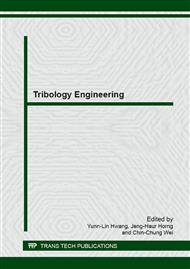p.99
p.104
p.110
p.115
p.120
p.125
p.130
p.135
p.141
Thermal Effects of Mechanical Polishing and Conditioning on Polishing Pads
Abstract:
Polishing process is a primary technique for planarization of material surface in manufacture fabrication. The pad structure and its material properties are important to determine the polish rate and planarity that can be achieved by the polishing process. Besides, the pad conditioning is used to regenerate the surface of the polishing pad surface by breaking up the glazed areas. Because the polishing and pad conditioning mechanism is inadequately understood and because higher levels of pad polishing performance are desired, the investigation of experiment becomes more important.In this paper, a high precision polishing machine has established. With an improved design, a test rig can be easily used to simulate the polishing, pad conditioning process and acquire the signals of temperature. The temperature of test pads (i.e. Rodel IC1000A, Rodel IC 1000B and Opetech SB 660) is measured during polishing and pad conditioning process. For the self-design test rig, its surface temperature is measured by T-type thermocouples screwed behind the polishing (or conditioning) interface of the carrier. The experimental results provide a temperature index to end-point-detection and contribute to understanding of the mechanism on polishing pads.
Info:
Periodical:
Pages:
120-124
Citation:
Online since:
April 2015
Authors:
Keywords:
Price:
Сopyright:
© 2015 Trans Tech Publications Ltd. All Rights Reserved
Share:
Citation:


